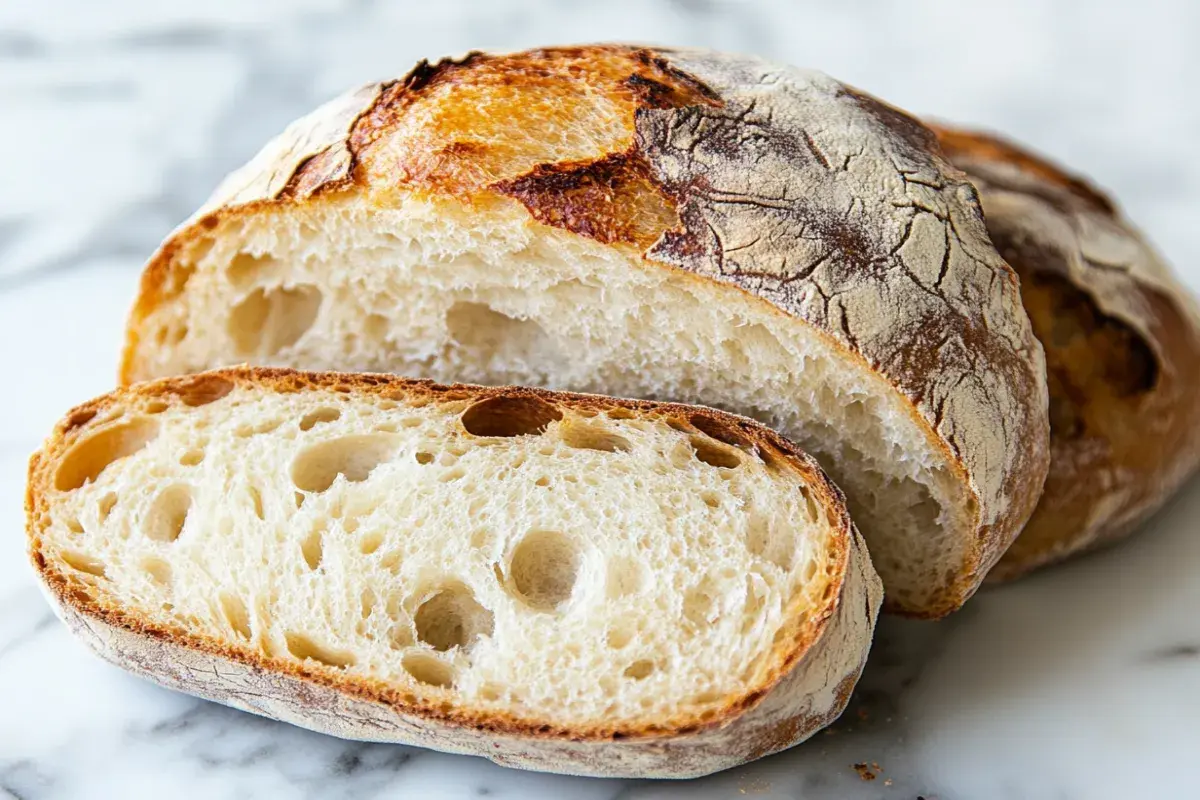Sourdough bread has long been a favorite in bakeries and home kitchens alike. With its unique flavor and crunchy yet chewy texture, many people wonder if sourdough bread is a good choice for sandwiches. In this article, we’ll explore the various benefits of using sourdough for sandwiches, from nutritional perks to versatility in recipes.
What Makes a Good Sandwich Bread?
When it comes to making the perfect sandwich, the bread is just as important as the fillings. A good sandwich bread should provide the right balance of texture, flavor, and structure to complement your ingredients. Here are the key qualities to look for in an ideal sandwich bread:
Texture
- Firm yet soft interior: A good sandwich bread should have a soft interior that complements the fillings while being firm enough to hold them together.
- Sturdy crust: The crust should be slightly crunchy to add texture without overpowering the sandwich or becoming too hard to bite through.
- Resistant to sogginess: Bread that quickly becomes soggy can ruin a sandwich, especially when using moist ingredients like tomatoes, sauces, or pickles. A good sandwich bread holds its structure even with wet fillings.
Flavor
- Neutral or complementary flavor: The bread should either have a neutral flavor that doesn’t overpower the sandwich or a flavor that enhances the ingredients, like the tanginess of sourdough.
- Versatility: The bread should work well with both savory and sweet fillings, making it versatile enough for different sandwich types.
Structure and Size
- Sturdy and sliceable: The bread needs to be easy to slice evenly for a clean sandwich. It should also be thick enough to hold ingredients without falling apart.
- Flexible for different sandwich types: Whether you’re making a toasted sandwich, a cold sandwich, or a panini, the bread should work well in all forms, offering versatility for various preparations.
Sourdough bread excels in all of these areas, making it an excellent choice for sandwiches. Its balance of chewy texture, robust flavor, and ability to stay firm under moist fillings sets it apart from other bread types.
Why Choose Sourdough for Sandwiches?
Sourdough bread stands out among other types of bread due to its unique fermentation process, which impacts its texture, taste, and even digestibility. According to King Arthur Baking’s recipe, sourdough sandwich bread provides a balance between the chewy, hearty structure and the subtle tang that enhances the flavor of fillings.
Additionally, sourdough bread offers several health benefits that make it a popular choice for those who are health-conscious or managing digestive issues. True Sourdough highlights how the fermentation process breaks down gluten, making it easier to digest compared to other breads.
Texture and Flavor: A Perfect Base

One of the reasons sourdough bread is such a popular choice for sandwiches is its distinctive texture and flavor, which make it a versatile and sturdy base for a wide range of fillings.
Chewy and Crunchy Texture
Sourdough bread has a unique balance between a chewy interior and a crunchy crust. This texture is ideal for sandwiches because it:
- Holds up well with heavy or moist ingredients, such as roast beef, avocado, or sauces, without becoming soggy.
- Provides a satisfying contrast with soft fillings like cheese or deli meats.
Whether you enjoy your sandwiches toasted or fresh, the texture of sourdough adds a delightful bite that enhances the overall eating experience.
Tangy, Subtle Flavor
The slightly tangy flavor of sourdough comes from the natural fermentation process. This tanginess pairs exceptionally well with both savory and sweet sandwich ingredients, making it a versatile option. Some perfect pairings include:
- Savory combinations like turkey, bacon, and avocado, where the sourdough’s flavor complements the richness of the fillings.
- Sweet fillings like peanut butter, jam, or honey, where the tangy notes add complexity to the sweetness.
Sourdough’s flavor and texture make it a perfect match for a variety of sandwich styles, from gourmet creations to simple lunchtime favorites. Whether you’re crafting a sophisticated sandwich or a quick snack, sourdough’s versatility will elevate your sandwich game.
Tangy, Subtle Flavor
The slightly tangy flavor of sourdough comes from the natural fermentation process. This tanginess pairs exceptionally well with both savory and sweet sandwich ingredients, making it a versatile option. Some perfect pairings include:
- Savory combinations like turkey, bacon, and avocado, where the sourdough’s flavor complements the richness of the fillings.
- Sweet fillings like peanut butter, jam, or honey, where the tangy notes add complexity to the sweetness.
Sourdough’s flavor and texture make it a perfect match for a variety of sandwich styles, from gourmet creations to simple lunchtime favorites. Whether you’re crafting a sophisticated sandwich or a quick snack, sourdough’s versatility will elevate your sandwich game.
Nutritional Benefits of Sourdough Bread
Sourdough bread not only tastes great but also offers several nutritional advantages, making it a healthier choice for sandwiches compared to many other types of bread.
Lower Glycemic Index
Sourdough bread has a lower glycemic index than traditional white bread. This means it causes a slower rise in blood sugar levels, making it a good option for those who want to manage their blood sugar or are looking for sustained energy throughout the day.
Easier Digestion
The fermentation process used to make sourdough helps to break down gluten and phytic acid, which can make it easier to digest. This is particularly beneficial for individuals with mild gluten sensitivities or those who experience digestive discomfort from other types of bread.
Rich in Probiotics
Thanks to the natural fermentation process, sourdough contains beneficial probiotics that promote gut health. While the baking process kills most of these probiotics, the prebiotics that remain help feed the healthy bacteria in your gut, contributing to better digestion.
Higher Nutrient Absorption
The long fermentation of sourdough also helps to release essential nutrients, such as magnesium, zinc, and B vitamins. These nutrients are more easily absorbed by the body, making sourdough a more nutrient-dense option than highly processed bread varieties.
By incorporating sourdough bread into your sandwiches, you can enjoy a bread that not only tastes great but also supports your overall health and well-being.
Popular Sourdough Sandwich Ideas
Whether you’re making a breakfast sandwich, a quick lunch, or a hearty snack, sourdough bread can elevate your sandwich game. Here are some of the best sandwich combinations to try:
- Grilled Cheese: The crunchy exterior of toasted sourdough makes it the perfect vessel for a gooey, cheesy interior.
- Turkey and Avocado: The tangy taste of sourdough pairs well with the richness of turkey and creamy avocado.
- Roast Beef and Horseradish: The robust flavors of roast beef are enhanced by the slightly sour flavor of the bread.
For more sandwich inspiration, you can explore these 7 Killer Sourdough Sandwich Recipes that showcase the versatility of this bread.
Practical Tips for Using Sourdough in Sandwiches

To get the best out of sourdough for sandwiches, consider these tips:
Choose the Right Type of Sourdough
Not all sourdough bread is the same, and selecting the right type is essential for making the perfect sandwich. Here’s what to consider when choosing your sourdough:
Artisanal vs. Commercial Sourdough
- Artisanal Sourdough: This variety is usually made by hand with long fermentation times, giving it a thicker, crustier exterior and a denser crumb. It’s great for hearty sandwiches like roast beef or pastrami but may be too thick for delicate fillings.
- Commercial Sourdough: Softer and more uniform in texture, this type is easier to slice and makes for a more balanced sandwich. It works well for everyday sandwiches like turkey, cheese, or grilled vegetables.
Sourdough Sandwich Bread
- Look for sourdough sandwich loaves specifically designed for sandwich-making. These are typically softer, with a thinner crust, making them ideal for consistent slicing and better fitting into a sandwich press or toaster.
Whole Wheat or Rye Sourdough
- For a more nutritious option, consider sourdough made with whole wheat or rye flour. These varieties offer a richer flavor and denser texture, which works well with robust fillings like cured meats, cheeses, and grilled vegetables.
By choosing the right type of sourdough, you can enhance the overall texture and flavor of your sandwiches, ensuring that each bite is a delightful experience.
Storage and Preparation
To ensure your sourdough bread stays fresh and ready for sandwiches, here are some key storage and preparation tips:
Storing Sourdough Bread
- Room Temperature: Keep sourdough in a paper bag or wrapped in a clean kitchen towel at room temperature. This allows air circulation, which prevents the crust from becoming too soft.
- Avoid Plastic Bags: Avoid storing sourdough in plastic bags as they trap moisture, leading to a soggy crust.
- Freezing: For longer storage, slice the bread and freeze it in an airtight bag. When you need slices, simply toast or thaw them for a fresh taste.
Slicing and Preparation
- Use a Bread Knife: A sharp serrated bread knife will help you slice through sourdough’s chewy crust without crushing the softer interior.
- Toasting for Crunch: Lightly toasting sourdough enhances its texture, making it crispy on the outside but soft and airy on the inside—perfect for both cold and toasted sandwiches.
Slicing and Preparation
- Use a Bread Knife: A sharp serrated bread knife will help you slice through sourdough’s chewy crust without crushing the softer interior.
- Toasting for Crunch: Lightly toasting sourdough enhances its texture, making it crispy on the outside but soft and airy on the inside—perfect for both cold and toasted sandwiches.
FAQs About Sourdough and Sandwiches
Is Sourdough Good for Toasted Sandwiches?
Absolutely! Sourdough bread holds up exceptionally well when toasted. The crispy crust develops even more crunch while the interior remains soft, making it a great base for grilled sandwiches like grilled cheese or paninis.
Is Sourdough Healthier Than Other Breads for Sandwiches?
Yes, sourdough can be a healthier option compared to white or even whole wheat bread due to its fermentation process. It’s easier to digest and has a lower glycemic index, which means it’s less likely to cause blood sugar spikes. Additionally, the presence of prebiotics and beneficial bacteria makes it a gut-friendly choice for your sandwiches.
Does Sourdough Get Soggy Easily?
One of the best things about sourdough is that it doesn’t get soggy easily. Its firm texture and slightly dry crumb help it resist absorbing too much moisture from sandwich fillings. However, if you’re using particularly moist ingredients, such as tomatoes or pickles, consider adding a layer of cheese or lettuce to act as a moisture barrier.

Conclusion
So, is sourdough bread good for sandwiches? The answer is a resounding yes. With its robust flavor, chewy texture, and numerous health benefits, sourdough bread enhances nearly any sandwich. Whether you’re making a hearty roast beef sandwich or a simple grilled cheese, sourdough is an excellent choice that will elevate your meal.

